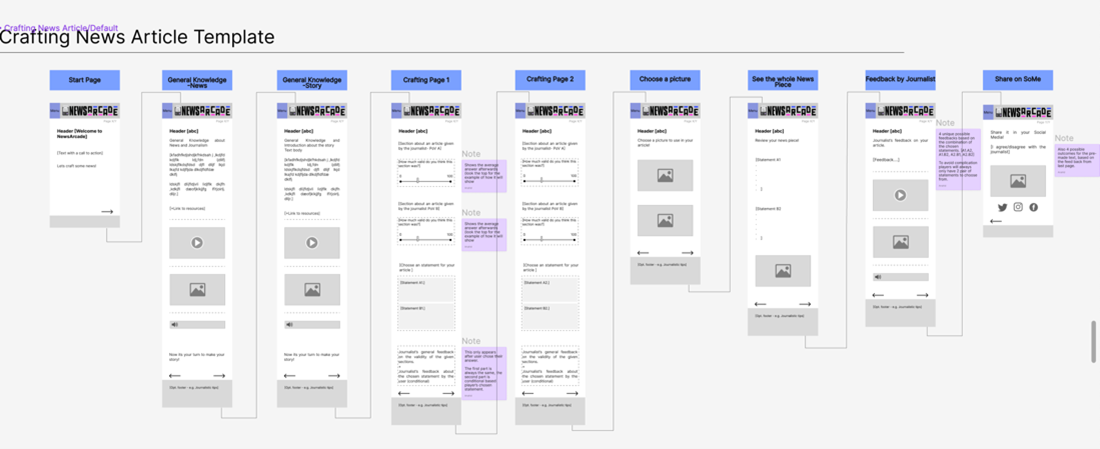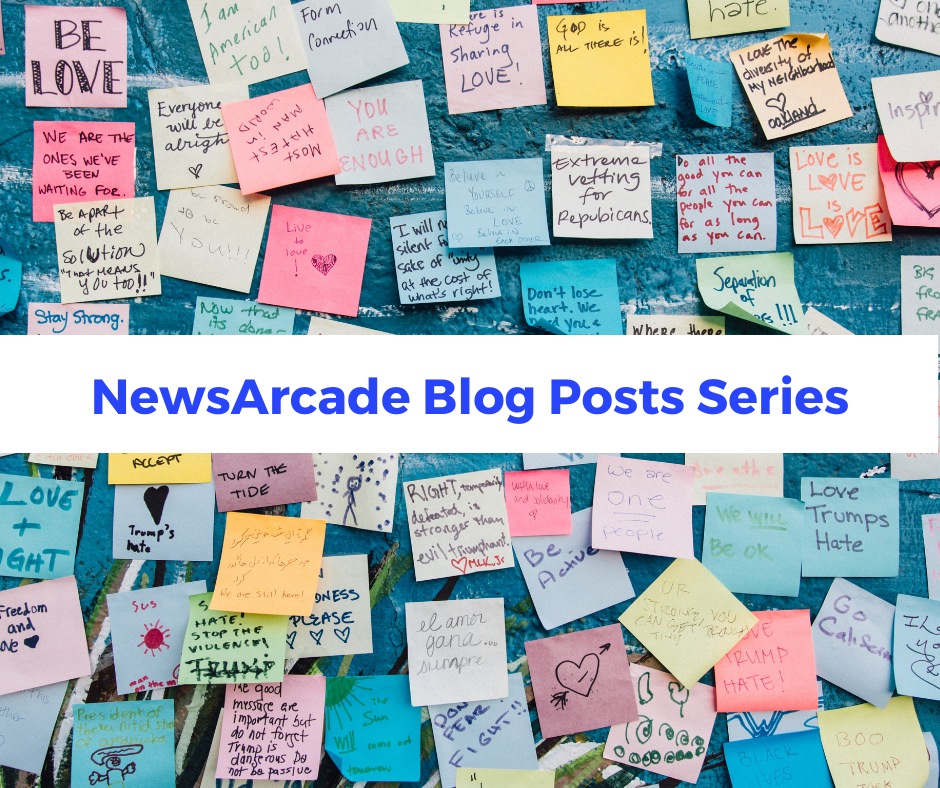In the early days of spring, NewsArcade entered a new phase. And from a journalistic standpoint, this is the most stimulating one: we are putting stories together.
After burgeoning for a few months, the project is blossoming to produce its first fruits in a matter of days. They are not good enough yet to be shared with the outside world, but they will nourish our experiments. They are just dedicated to teaching us what to do and how to do it. They are, in a nutshell, the ‘fruits of NewsArcade knowledge’. But enough with puns and silly metaphors, time to slice open the process, select the meatiest pieces and see what we are about to digest.
As the partners finally agreed upon a game format, Portaplay and In2 collaborated in designing the tool into which publishers will input their content to create a gamified version of news.
It was presented to the consortium as a “figma”, a format used to create collaborative designs. From a writer’s point of view, it looks like a segmentation of the content that will be used by the player. This is extremely useful as it automatically structures the story in 4 main elements: 4 statements, each of them supported by 1 quote.

The figma has a massive advantage in balancing the story between at least 2 points of view, each supported by 2 quotes or building a story around 1 main point and offering corroborative or contradictory statements.
The first question we had to answer was to figure out what kind of story we needed, a story that would enable us to implement the structure.
We also had to find a story that would withhold the test of time, a topic that would remain relevant in the coming months throughout the experimentation phase.
As the fastest and least certain news topic of the year (decade?), Artificial Intelligence seemed to fit all these requirements. It was relevant, polarizing, required expertise -henceforth experts and quotes- and was extremely likely to stay in the news for a while.
AI TO THE RESCUE
But as interesting as AI can be, we needed to zero in on a specific angle that could be of interest to adults (who will test the game first) and potential end-users: young people.
A quick search through leading articles related to AI at the time lead us to focus on the implication of AI on the job market. A flurry of online articles all referred to a study by two Goldman Sachs’ economists that predicted Ai could lead to erasing 300 million jobs. It is a global topic, both current and prospective, that can interest actual workers and future ones. Also, it provides strong arguments for and against AI in the workplace, its impact on the job market and the global economy.
But, once we sifted through the dozens of very similar versions of the same AP story based on the Goldman Sachs report that were available on news websites, we ended up with different comments, points of view on the topic, but not one main, complete article. It became apparent that to fit the criteria set by the game designer it would be necessary to write a new article, compiling all leading elements gathered from news websites (CNN, Business insider, Reuters, Guardian…). First, we had to locate the report by the Goldman Sachs economists that was quoted multiple times, but never linked to; and then rebuild a balanced article with contradicting and/or complementary statements.
Did that mean we would have to write new material every time we wanted to format a story in NewsArcade ?
If so, could we host this specifically tailored story on NewsArcade’s servers or somewhere else?
And would we give access to that full story to the players? And at what stage?
What would the implications for publishers be?
FOLLOW THE RECIPE
With these questions in mind, we set out filling in the sections of the figma.
Journalistically, the process is interesting as it forces the writer to slow their pace and look at what they are doing instead of moving automatically through the regular stages of putting elements together. The different sections pave the way towards completing the story. They start with a short text of journalistic knowledge and invite the player to apply the principles when playing the game.
Once they have selected statements and created their piece, a player gets feedback on his choices, explaining why the selection makes sense or is lacking journalistic principles. A headline is also generated.
For the publisher who will onboard NewsArcade, this means it will need to allocate some production time in adapting a new story to the format. Coming up with 4 different angles and 4 headlines from the same material requires some attention, but nothing a seasoned writer can’t achieve in 15 to 30 minutes.
Quickly, it also became apparent that there is another side to the benefit of following the structure: there is a risk of automating the narrative, to the detriment of style. Good journalistic pieces tell an important or interesting story, but they are also well written. Style can help keep the reader engaged, or it can be subdued to the minimum not to interfere with the facts. In both cases, it serves the purpose of telling the story the best way possible. Thus, we need to make sure that for the sake of variety and palatability to the reader, NewsArcade stories cannot all look alike. We must find ways to shorten or lengthen some content when needed and investigate the possibility of offering different formats.
NURISHING INGREDIENTS
To recap this first assessment of putting together a story, it appears that, even if the structure of the game is quite rigid (and so should it be),
- publishers can adopt NewsArcade without having to compromise on journalistic principles,
- they don’t need to oversimplify stories to make them accessible but might have to take more cautionary steps in presenting them, as the type of engagement a subscriber would have towards a news-brand might be stronger than the occasional players’.
- the feedback section is a clever way to keep the story attractive and the game stimulating without having to overload the content with intellectual content. It supports the progression of the player but does not overload the game-ability.
After the whole text was organised according to Figma requirements, Portaplay integrated it in the Figma and then the CMS. It gave the partners a palatable first experience of what NewsArcade could be like.
Amongst the many feedbacks: 2 were more particularly striking:
- the chosen story was not polarizing enough, thus at risk of not being attractive enough;
- the educational side of the project was more subdued than expected. Learning about news happened when discovering feedback about one’s choices but didn’t come as a clear enough educational process.
Thus, Alliance and NISV partnered to come up with a second story, that could address both issues at the same time.
SECOND COURSE
Finding a very divisive topic, with strong arguments, was not too hard. Amongst the global topics that could engage young adults (war, global warming, inequality, gender representation…) one story jumped to our attention: the ban of transgender athletes from international competitions by World Athletics.
But just like with the AI-jobs story, most of the articles we found were taken from the same AP or Reuters pieces and re-written. Yet, local angles (US, Australia, GB) were more exploited and led to a larger array of interesting comments. All in all, it confirmed the need to rewrite a sort of collage story to fit the Figma structure. It also confirmed the need of serious editorial input to turn a good story into a game.
- For publishers, the quality of their NewsArcade output will rely on the quality of their editorial input. Basically, you reap wat you sow.
After writing the story and playing around with coming up with headlines and feedback, Alliance and SVU completed a new playable piece that confirmed the need for editorial input and highlighted the need for more educational content.
Thus, it was decided to add a page at the beginning of the players’ progression with journalistic routines, tips, and tricks before users start playing. It is useful, but also fair to know the rules by which your performance will be evaluated!
Moreover, as any educator (parents included) knows, repetition is key, so it was also agreed to make sure those points are coming back within the choices and feedback throughout the game.
DIGESTION
Duplicating the stories was a stimulating way to get deeper understanding of the game requirements and the potential challenges for publishers. It was a good idea not to put all our fruits in the same basket. Instead, we are experimenting with different combinations and seasoning. Of course, there is no perfect recipe, and personal taste is important when it comes to news. Nonetheless, we ‘re setting cardinal steps in our process, trying to avoid unpalatable combinations (oysters with chocolate anyone?).
To tie up our original analogy, NewsArcade is more complex than a fruit plate and more subtle than a fruit salad. It doesn’t claim to be the cherry on the cake of media literacy, yet, it has the potential to list rather high on the menu of news innovation to reach younger audiences. Bon appétit.

